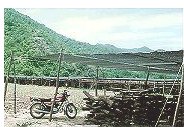

China 
 |
Wood Energy Situation Policies and Programmes Wood Energy Data Further Reading RWEDP Focal Points |
Wood Energy Situation
In 1994, woodfuels accounted for 11% of the total energy consumption in China, and biomass for 24%. Biomass is a particularly important source of energy in rural areas. According to a survey on the rural energy situation carried out by the Forest Department in 1993, total rural energy consumption was 19,079 PJ, of which 24% came from agriculture residues, 18.6% from fuelwood and approximately 4% from other biofuels, e.g. biogas. From data published by the Ministry of Agriculture (December 1994), it can be deduced that in absolute terms the consumption of fuelwood in China has remained almost constant over the last 14 years, regardless of the decline of its share in national energy consumption.
The shortage of rural energy in China grew, particularly during the years of the Cultural Revolution, when massive tree felling took place. In recent years rural energy shortages have been relieved in the eastern provinces by supplies of oil, coal and gas. However, in the south-western provinces rural energy shortages are still very severe, as these provinces are far from fossil fuel supplies. Fuelwood plantations are successful in these areas, particularly on farmland in the valleys. On the hills limited progress has been made so far. One such example is Yunnan Province, which has a population of 40 million people from 26 different ethnic groups. Options for alternative energy are limited in this part of the country.
China has been remarkably successful in afforestation. Forest cover increased from 8% in 1950 to 14.3% in 1995, and the government is determined to increase it further. So far, 5 million hectares of fuelwood plantation has been established, which is 3.8% of closed forest cover. Forest areas supply 167 million tons of fuelwood annually. However, consumption is estimated to be 213 million tons and is expected to be 250 million tons in 2010.
Policies and Programmes
 Since 1980, China, perhaps more than any other country, has given great attention to finding new energy sources for its rural inhabitants. Earlier successes in promoting fuel saving stoves, rural electrification and biogas systems have together formed the "Integrated Rural Energy Development" (IRED) programme. The programme, under the Ministry of Agriculture, is unique among major development initiatives in that it is designed and financed exclusively by the Chinese Government and people without outside assistance. IRED blends centralised and decentralised functions with national planning and information exchange, involving the co-operation of eight ministries. As part of the 9th plan period (1996-2000) efforts will be made by the Ministry of Forestry to more than double the country's forest areas, particularly in mountain areas, before the year 2010. Among the objectives is increasing the fuelwood supply.
Since 1980, China, perhaps more than any other country, has given great attention to finding new energy sources for its rural inhabitants. Earlier successes in promoting fuel saving stoves, rural electrification and biogas systems have together formed the "Integrated Rural Energy Development" (IRED) programme. The programme, under the Ministry of Agriculture, is unique among major development initiatives in that it is designed and financed exclusively by the Chinese Government and people without outside assistance. IRED blends centralised and decentralised functions with national planning and information exchange, involving the co-operation of eight ministries. As part of the 9th plan period (1996-2000) efforts will be made by the Ministry of Forestry to more than double the country's forest areas, particularly in mountain areas, before the year 2010. Among the objectives is increasing the fuelwood supply.
However, it should be noted that although there are many alternative renewable energy programmes, including biogas, they still cater for only a small percentage of rural energy needs. The mainstream fuels supplied to the rural population are still wood and other types of biomass. It is not surprising that experts from China have stated an interest in briquetting agri-residues to provide woodfuel alternatives.
Wood Energy Data
| General | |||||
| Population (1996) | 1,232 mln. | ||||
| Share of Rural Population | 68.8% | ||||
| GDP per capita (1995) in constant 1987 US$ | 436 | ||||
| Energy Consumption (1995) | |||||
| Total Final Energy Consumption in PJ | 34,598 | ||||
| Consumption of Wood Energy in PJ | 3,390 | (9.8%) | |||
| Consumption of Biomass Energy in PJ | 7,844 | (22.7%) | |||
| Wood Energy Resources | |||||
| Forest Area (1995) in 1000 ha | 133,323 | (14.3%) | |||
| Natural Forest Area (1995) in 1000 ha | 99,523 | (10.7%) | |||
| Agricultural Area (1994) in 1000 ha | 532,600 | (57.3%) | |||
| Share of Woodfuels from Forest Areas (1993) | 40.6% | ||||
| Potential Wood Energy Supply (1994) | |||||
| Sust. Supply from Natural Forest in kton | 119,329 | ||||
| Sust. Supply from Forest Plantations in kton | 116,212 | ||||
| Sust. Supply from Agriculture Areas in kton | 288,700 | ||||
| Sust. Supply from Other Wooded Land in kton | 15,957 | ||||
| Supply from Wood Waste from Deforestation in kton | 58,347 | ||||
| Total Potential Supply in kton | 598,546 | ||||
| Primary Wood Energy Requirements in kton | 219,122 | ||||
Notes:
Population and land use data from FAO (FAOSTAT), GDP per capita from World Bank. Energy consumption data from various sources.
Potential wood energy supply estimated by RWEDP, based on available data for land use, wood productivity and estimates on availability of wood for energy use. For forest land, other wooded land and agriculture areas, the potential supply is based on average annual yield estimates, assuming a sustainable use of resources (Sust.: sustainable). Wood waste from deforestation refers to wood potentially available from natural forest land cleared due to commercial logging, expansion of agriculture land or other reasons. The estimates are based on aggregated national data, which can hide local variations, ranging from scarcity to abundance. For detailed calculations and estimates for 2010, see FD50, chapter 8
Further reading:
| Regional Study on Wood Energy Today and Tomorrow in Asia, Field Document 50, 1997 | |
| Chapter 5 in Review of Wood Energy Data in RWEDP Member Countries, Field Document 47, 1997 | |
| Chinese Fuel Saving Stoves: A Compendium, Field Document 40, 1993 | |
| Oak - Production, Management and Use in the Himalayas, Field Documents No. 27, 1991 | |
| Wood Energy in China, Wood Energy News, Vol.13.3 , 1998 |
RWEDP Focal Points in People's Republic of China
Focal points are the main contacts for RWEDP in a member country. Generally, in each country, there is one focal point in the energy sector, and one in the forestry sector.
| Institute of Forestry Chinese Academy of Forestry Beijing TEL: 86-10-62889645 FAX: 86-10-62872015 | Institute of Energy and Environment Protection Chinese Academy of Agricultural Engineering, Research and Planning Beijing TEL:86-10-64193003 FAX: 86-10-65002448 |
Comments, questions? webmaster@rwedp.org
© FAO-RWEDP, 1999